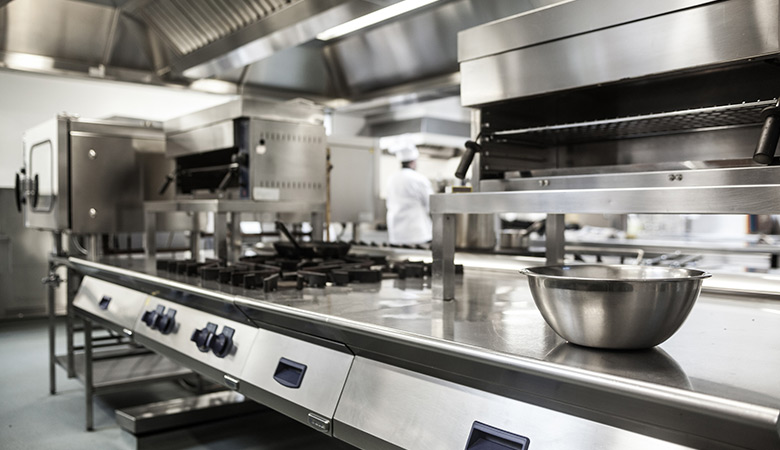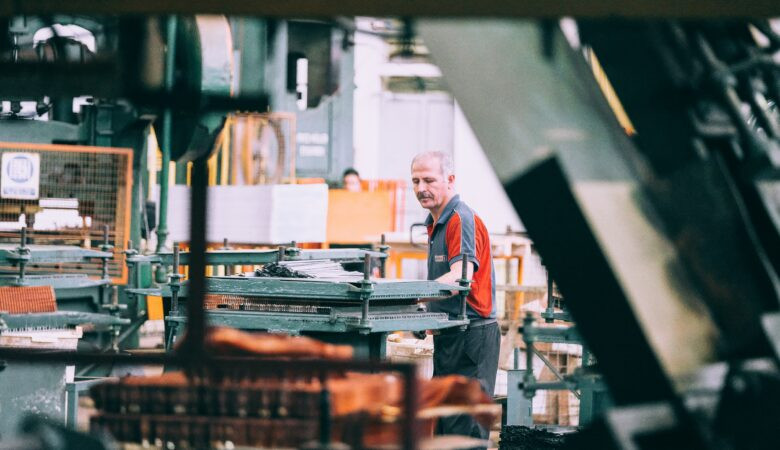Technologie / Articles
5 équipements essentiels de cuisine professionnelle
Découvrez quels sont les 5 équipements essentiels de cuisine professionnelle, pourquoi ils sont si importants et comment choisir la meilleure option.

 10 minutes de lecture
10 minutes de lecture
2022-03-17 19:14:05
Les équipements de cuisine professionnelle peuvent faire toute la différence dans la gestion d'une affaire. Ils augmentent la productivité, garantissent la sécurité des professionnels et le bien-être des clients. Ils représentent cependant un investissement considérable. Il est donc important de savoir comment choisir et tirer le meilleur parti de ces machines.
Découvrez quels sont les 5 équipements indispensables pour toute cuisine professionnelle et comment choisir la meilleure option.
1. Fours commerciaux
Les fours sont l'un des équipements industriels les plus importants pour toute entreprise. D'un côté, ils permettent d'atteindre des températures plus élevées que celles des fours traditionnels, ce qui donne à n'importe quelle équipe une plus grande liberté créative en cuisine. D'autre part, ils ont une plus grande capacité, ce qui permet de servir un plus grand nombre de personnes en même temps. Pour finir, ils sont également plus efficients que les solutions traditionnelles.
Il existe plusieurs options de fours industriels, avec des méthodes de fonctionnement distinctes. Voici les modèles les plus courants sur le marché:
- Le four à convection est le type de four le plus courant dans les cuisines commerciales, en raison de sa polyvalence en termes d'élaboration, de chauffage et réchauffage des aliments. Ils sont normalement équipés d'autres appareils, comme des plaques, des grilles et des friteuses.
- Le four à convection au gaz présente une efficience énergétique de cuisson de 30 % alors que celle de ceux à convection électrique est de 20 %. Cet équipement à gaz dispose de systèmes de protection lorsqu'il fonctionne, comme les détecteurs de flammes ou les contrôles de température. Ils sont ainsi aussi sûrs que les fours à convection électriques.
- Les fours à convection combinés permettent d'obtenir une cuisson rapide et de grande qualité. La chaleur est appliquée à l'extérieur et à l'intérieur des aliments, ce qui garantit une texture riche et un aspect croquant.
Les fours industriels utilisent des accessoires comme les grilles, les plateaux ou les friteuses. Ces ustensiles peuvent accumuler des graisses qui, une fois brûlées, sont difficiles à enlever avec les méthodes traditionnelles. Pour ces cas-là, nous avons développé la Multiwasher, une machine de lavage industrielle à haute performance capable de nettoyer et de décarboniser en profondeur tout équipement de cuisine professionnelle. Ils gardent ainsi les aliments sûrs et évitent l'apparition et la propagation de bactéries.
2. Fourneaux industriels
Au contraire des fourneaux résidentiels, les industriels sont de plus grandes dimensions, ont plus de capacité qu'un four et peuvent supporter des accessoires spéciaux tels que les plaques et les grilles professionnelles.
En raison des hautes températures de fonctionnement des fourneaux, il est courant que leurs surfaces gagnent des résidus de carbone nocifs à la santé et accumulent des couches de graisse brûlée. Avec la Multiwasher, il est possible de retirer les substances chimique des équipements de cuisine professionnelle, grâce à une hygiénisation profonde des superficies, et de permettre qu'aucune maladie ne soit transmise à partir des aliments.
La technologie de pointe de la Multiwasher a été conçue pour obtenir les meilleurs résultats avec un coût de maintenance et des frais énergétiques les plus faibles possibles.
3. Réfrigérateurs commerciaux
Un des principaux avantages associés aux réfrigérateurs professionnels est leur capacité d'économiser une quantité considérable d'énergie électrique. De plus, ces équipements de cuisine professionnelle disposent de compresseurs haut de gamme qui aident à contrôler efficacement la température des aliments.
Il existe plusieurs types de réfrigérateurs pour les équipements de cuisine professionnelle. Pour choisir, vous devez prendre en compte le type de cuisine et les besoins spécifiques de chaque établissement.
- Reach-In : c'est l'un des types de réfrigérateur les plus courants dans les cantines, les restaurants et les hôtels. Ils correspondent à une version plus large des réfrigérateurs domestiques et dispose d'une puissance de réfrigération et d'un espace de stockage beaucoup plus importants.
- Walk-In : ce sont des cabines de réfrigération capables de fournir un espace de réfrigération tout en dépensant moins d'énergie. C'est un type courant de réfrigérateur pour les restaurants.
- Sous le comptoir : ilspermettent un accès et une manipulation rapides en ce qui concerne les produits, lors de l'élaboration et de la préparation sur une ligne de montage. Ce sont des cabines au design discret, se trouvant sous le comptoir, pour stocker des aliments préparés ou des mises en place (aliments coupés et traités).
- Tables de préparation réfrigérées : elles permettent au travailleur de trouver les produits alimentaires et de les préparer sur la table de travail. Ce sont généralement des réfrigérateurs destinés aux préparations rapides comme les sandwichs, les salades ou les pizzas.
Les étagères et les filtres des réfrigérateurs doivent être nettoyés régulièrement afin de garantir la sécurité des aliments et d'éviter la propagation des bactéries. La Multiwasher a été conçue en pensant à la meilleure forme d'exécuter cette tâche avec efficacité, durabilité et polyvalence. Cet appareil de lavage industriel est capable de laver en profondeur tout équipement de cuisine professionnelle en utilisant 2/3 d'eau en moins que les autres machines.
4. Friteuses commerciales
Les friteuses professionnelles diminuent le temps de production tout en maintenant la qualité, la texture et le goût des aliments. Ces équipements de cuisine professionnelle sont considérés plus sains que les friteuses traditionnelles, car ils utilisent moins d'huile. Ils sont également plus faciles à nettoyer et permettent de ne pas avoir d'odeurs dans les zones de préparation de la cuisine.
Il existe deux types principaux de friteuses.
- Friteuses de table : elles présentent un design optimisé pour être transportées facilement et économiser de l'espace sur les tables de service. Elles sont faciles à manipuler et parfaites pour les espaces de production de petites dimensions.
- Friteuses sur pieds : elles sont indiquées pour les établissements ayant un faible volume quotidien de production. Elles exigent généralement moins de maintenance et de temps de récupération entre les lots de fritures.
En raison des hautes températures auxquelles les aliments sont cuisinés et de l'utilisation fréquente de ces équipements de cuisine professionnelle, il est nécessaire que leurs superficies et les accessoires (grilles, dépôts, récipients, pinces) soient lavés efficacement. La Multiwasher garantit un lavage parfait de tous les ustensiles et équipements en utilisant 70 % de détergent en moins.
5. Machine de lavage industrielle
La machine de lavage industrielle est un autre équipement essentiel pour n'importe quel établissement. Parmi les nombreuses options du marché, la MultiWasher se distingue en étant un exemple d'efficacité, de productivité, de sécurité et de durabilité. Parmi les principaux avantages de cet équipement, se distinguent :
- Réduction du temps de lavage. Les cycles de lavage durent généralement entre une et quatre minutes, contre une moyenne de 30 minutes pour les modèles résidentiels avancés.
- Augmentation de l'ergonomie. Ces machines sont plus faciles à utiliser en raison de leur taille et de la capacité en termes de vaisselle et accessoires lavés en même temps. La Multiwasher a été conçue dans le format de cabine fermée pour que l'utilisation de son espace soit optimisée de la meilleure forme possible.
- Économie des ressources en termes d'énergie, d'eau et de détergent, à chaque lavage. Somengil a créé une solution pour laver les ustensiles et équipements industriels de forme efficiente et durable.
Somengil, le futur des équipements de cuisine professionnelle
La qualité et la performance des équipements de cuisine professionnelle sont pour nous une priorité. La Multiwasher est une machine de lavage de dernière génération, une solution créée pour optimiser la production et obtenir les meilleurs résultats de lavage possibles.
Contactez-nous et voyez la différence, ou marquez un webinar.
Tu pourrais aimer

Technologie / Articles
« Jusqu’à présent, les équipements étaient toujours développés dans un seul but. Les choses changent. »
Nous avons parlé avec Joni Regalado, responsable de la recherche et du développement chez Somengil, de la manière dont l’innovation peut aider le...
Publié dans 2022-10-27
























 Portugal
Portugal United Kingdom
United Kingdom United States
United States France
France Spain
Spain Germany
Germany Romania
Romania Italy
Italy Czech Republic
Czech Republic Finland
Finland Hungary
Hungary Slovakia
Slovakia Greece
Greece Lithuania
Lithuania South Korea
South Korea Russia
Russia Saudi Arabia
Saudi Arabia Poland
Poland Brasil
Brasil Hebrew
Hebrew